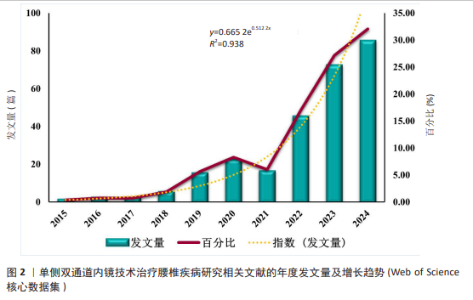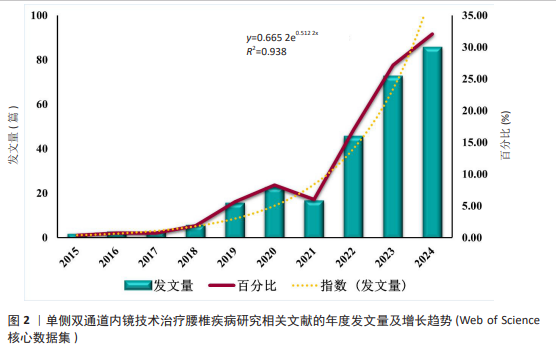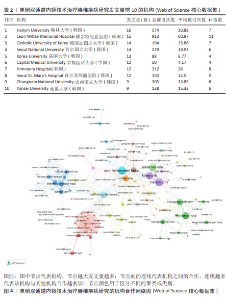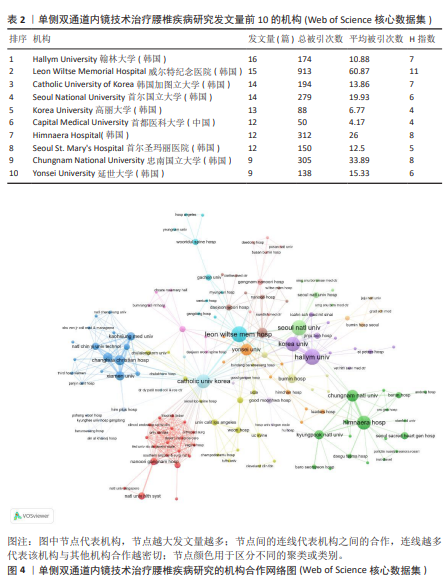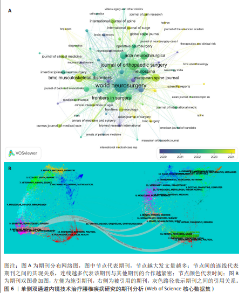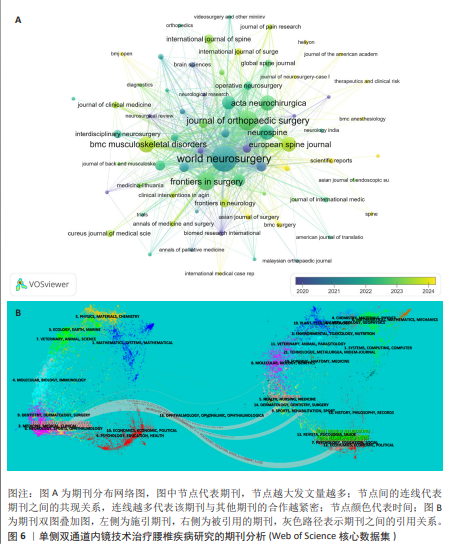Chinese Journal of Tissue Engineering Research ›› 2026, Vol. 30 ›› Issue (9): 2380-2390.doi: 10.12307/2026.578
Previous Articles Next Articles
Unilateral biportal endoscopic technology for treatment of lumbar degenerative diseases: global research status and changing trends
Wen Fayan1, 2, Li Yan1, Qiang Tianming2, Yang Chen2, Shen Linming1, Li Yadong1, Liu Yongming2
- 1Graduate School, Gansu University of Chinese Medicine, Lanzhou 730000, Gansu Province, China; 2Department of No.4 Spine Orthopedics, Gansu Provincial Hospital of TCM, Lanzhou 730050, Gansu Province, China
-
Received:2024-11-28Accepted:2025-03-01Online:2026-03-28Published:2025-09-30 -
Contact:Liu Yongming, Master’s supervisor, Chief physician, Department of No.4 Spine Orthopedics, Gansu Provincial Hospital of TCM, Lanzhou 730050, Gansu Province, China -
About author:Wen Fayan, Master candidate, Graduate School, Gansu University of Chinese Medicine, Lanzhou 730000, Gansu Province, China; Department of No.4 Spine Orthopedics, Gansu Provincial Hospital of TCM, Lanzhou 730050, Gansu Province, China -
Supported by:Lanzhou Science and Technology Bureau Project, No. 2024-4-40 (to LYM); Gansu Health Industry Scientific Research Project, No. GSWSKY2022-42 (to LYM)
CLC Number:
Cite this article
Wen Fayan, Li Yan, Qiang Tianming, Yang Chen, Shen Linming, Li Yadong, Liu Yongming. Unilateral biportal endoscopic technology for treatment of lumbar degenerative diseases: global research status and changing trends[J]. Chinese Journal of Tissue Engineering Research, 2026, 30(9): 2380-2390.
share this article
Add to citation manager EndNote|Reference Manager|ProCite|BibTeX|RefWorks
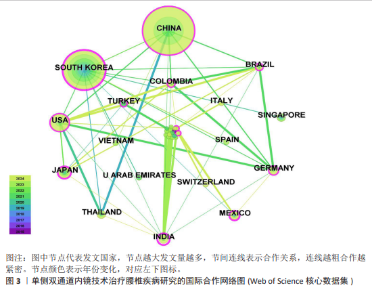
2.2 国家/地区分析 共56个国家/地区参与了过去10年关于UBE治疗腰椎疾病研究的发表。表1列出了发文量排名前7的国家。发表文章最多的国家是中国(142篇),其次是韩国(104篇)、美国(20篇)、日本(8篇)。有趣的是,韩国的总被引次数(2 510次)、平均被引次数(24.13次)和H指数(27)最高,这表明韩国发表的文献质量较高,对该领域做出了重大贡献。图3显示了国家/地区合作的网络图,图谱共包括32个节点和75条连线,网络密度为0.151 2。韩国对该领域的研究关注较早,自2016年持续至今;尽管中国在这一领域发表了最多的论文,但印度与其他国家的合作更为密切。总体来看,国家间合作较频繁。"
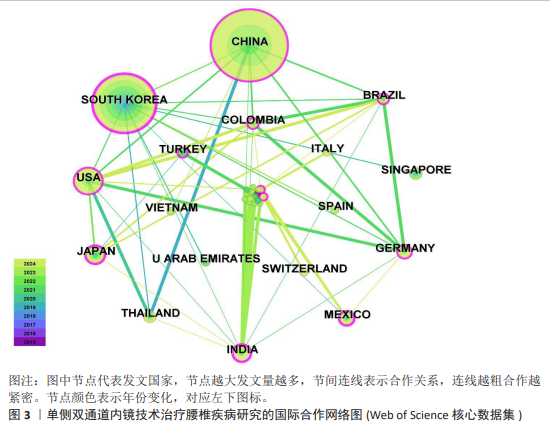
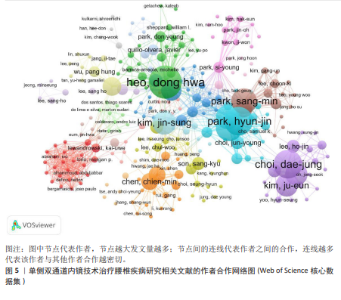
2.4 作者分析 超过1 000名作者参与了265篇文献的出版。如表3所示,发文量排名前10的作者中,90%来自韩国。来自The Leon Wiltse Memorial 医院的Dong Hwa Heo学者在该领域发表的论文数量最多(21篇),其总被引次数(958次)和H指数(13)最高;发文量排名第二的作者是Dae-Jung Choi(14篇);紧接着是Choon-Keun Park(13篇)、Sang-Min Park(12篇)、Jin-Sung Kim(11篇)、Ki-Han You(11篇)、Mingyang Kang(10篇)、Hyeun Sung Kim(10篇)、Ju-Eun Kim(10篇)和Hyun-Jin Park(9篇)。作者之间的合作相对分散,以小团体为主(图5)。"
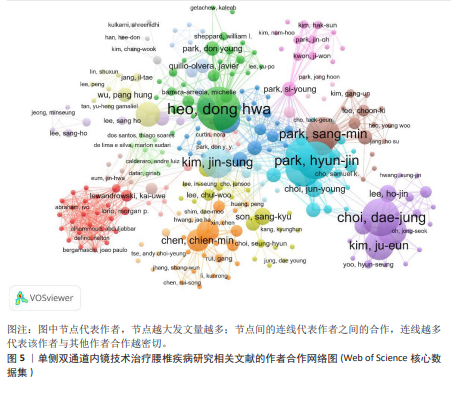
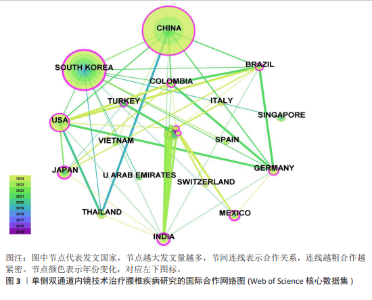
2.5 期刊分析 UBE治疗腰椎疾病相关研究的出版物发表在71种期刊上,影响最大的前10种期刊的相关出版物占全部出版物的55.85%,这些文章大多被发表在神经、肌肉骨骼等相关期刊上。其中《WORLD NEUROSURGERY》 对UBE治疗腰椎疾病的研究最为关注,发表相关文献35(13.21%)篇;其次是 《JOURNAL OF ORTHOPAEDIC SURGERY AND RESEARCH》《FRONTIERS IN SURGERY》《BMC MUSCULOSKELETAL DISORDERS》和《ACTA NEUROCHIRURGICA》。 然而,这10本期刊的整体影响因子较低。自2024年以来,该领域的相关文献逐渐发表在《SPINE》《SCIENTIFIC REPORTS》《BCM SURGERY》《BCM ANESTHESIOLOGY》和《ASIAN JOURNAL OF SURGERY》等期刊上(表4,图6A)。 此外,在此次研究中,CiteSpace软件用于绘制关于UBE治疗腰椎疾病研究相关期刊的双图叠加图(图6B)。左侧为施引期刊,右侧为被引用的期刊,引用关系用颜色路径表示,图中主要有3条灰色引用路径。在神经病学/运动机能学/眼科领域期刊上发表的文献大多引用了在心理学/教育学/社会学、运动机能学/康复学/体育学、健康学/护理学/医学期刊上发表的论文,其中神经病学/运动机能学/眼科和心理学/教育学/社会学在期刊上的联系更为紧密(z=3.437,f=210),受到广泛关注。"
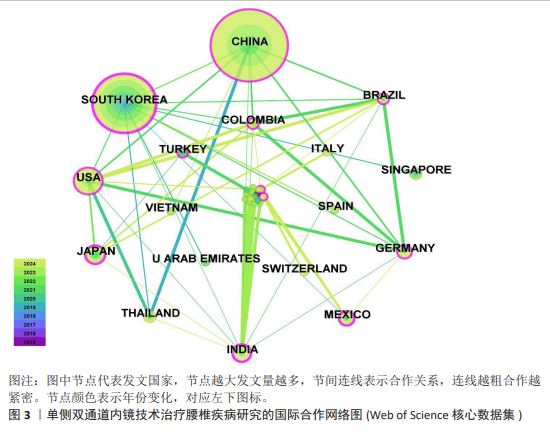
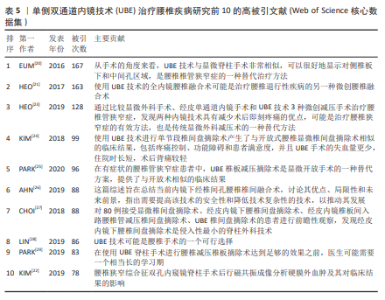
2.6 被引文献分析 高被引文献通常代表了研究领域的基本课题,研究热点可以通过计算被引频次和确定高被引出版物来确定[19]。被引用频次最多的前10篇文献如表5所示。这些文献不同程度地展示了UBE技术的优势,它被认为是腰椎退行性疾病的一种替代治疗方法[20-29]。这为腰椎疾病手术方式的选择提供了参考依据。排名第一的高被引文献为 EUM等[20]于2016年发表的文章,被引次数达到167次,该文对58例UBE减压术后患者进行了超过12个月的随访,结果发现与显微脊柱手术非常相似,UBE手术可以很好地显示对侧椎板下和中间孔区域,是退变性腰椎管狭窄症的一种替代治疗方法。紧接着是HEO等[21]发表的文章,指出使用UBE技术的全内镜腰椎融合术可能是治疗腰椎退行性疾病的另一种微创腰椎融合手术。KIM等[22]于2019年发表的文章特别强调了腰椎狭窄综合征双通道内窥镜脊柱手术后行MRI分析硬膜外血肿及其对临床结果的影响,发现术后硬膜外血肿的发生率高于预期。在不考虑患者的术后症状时,术后硬膜外血肿对术后结果有决定性的影响,如果椎管侵犯超过 50%并伴有症状,可能需要进行翻修手术,这对临床医生处理术后硬膜外血肿具有重要的参考意义。此外,操作者应提高技术水平,谨慎操作。"
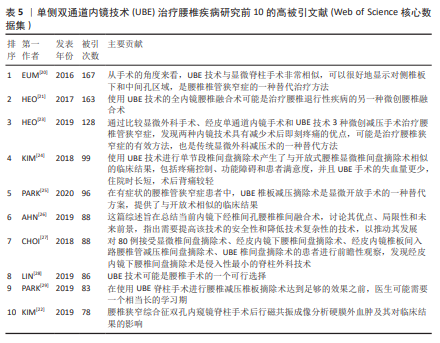
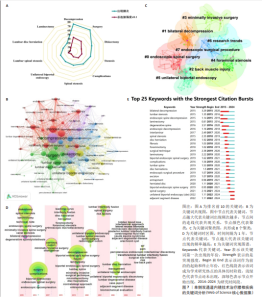
2.7 关键词分析 在此次研究中,使用VOSviewer从出版物中提取了797个关键词。“减压”是所有关键词的核心,出现频率最高(75次),与其他关键词关联最广(总连接强度=434);其次是外科手术、椎间盘摘除术、狭窄症、并发症、椎管狭窄症、UBE、腰椎椎管狭窄症、腰椎间盘突出症、椎板摘除术(图7A,B)。不难发现UBE主要应用于减压术、椎间盘摘除术、椎板摘除术,主要针对的疾病是腰椎椎管狭窄症和腰椎间盘突出症。 为了了解2014年以来UBE治疗腰椎疾病研究的前沿,使用CiteSpace对该领域的关键词进行聚类,序数0表示聚类最大。图7C显示了8个聚类:#0内镜脊柱手术、#1双侧减压、#2 背肌损伤、#3微创手术、#4椎间孔狭窄、#5 UBE、#6研究趋势、#7内镜手术,这些主题密切相关,表明与这些主题相关的研究是该领域近期的热门话题,处于研究的前沿。 图7D从时间维度可视化了UBE治疗腰椎疾病研究的热点和发展方向。如图所示,该领域的研究仍然处于起步阶段,学者在不断探索UBE技术的适应手术及临床效果。近两年隐匿性出血、脑脊液漏、手术部位感染、疼痛、风险等词相继出现,这表明研究者在追求技术进步的同时,也高度关注UBE技术相关的危险因素及并发症。 引用突发强的关键词还可以反映该领域的一些新兴学术趋势和热点话题,以及被用于预测前沿研究方向和揭示该领域潜在的热点[30]。图7E列出了引用突发最强的前25个关键词,突发最强的关键词是脊柱退行性疾病,突发强度为3.51。双侧减压是突发强度排名第二的关键词(突发强度为3.29)。其也是突发持续时间最长的关键词,自2015年持续到2020年,亦是最早出现的关键词之一。自2022年以来,UBE和邻近节段退变性疾病具有影响力,代表了当前该领域的热点和前沿。"
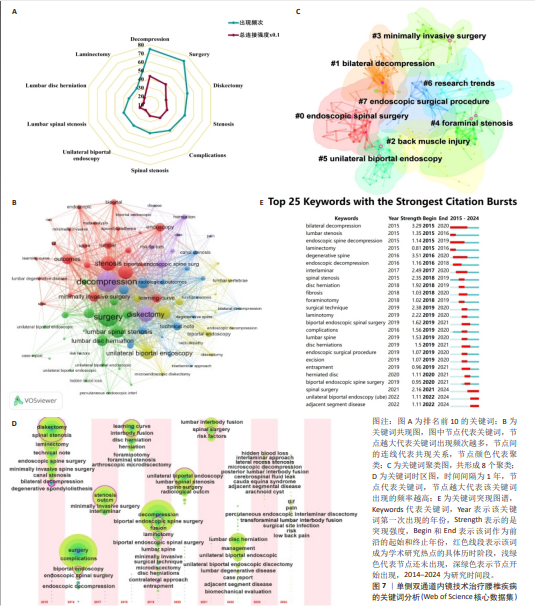
| [1] FAN X, XUE D, PAN Z, et al. Comparison of sagittal spinal alignment on standing plain x-rays and supine MRI in degenerative lumbar disease. Front Surg. 2023;10: 1103952. [2] 胡鹏,沈雄杰,常磊,等.腰椎退行性疾病腰椎椎间融合术后终板损伤的影响因素研究进展[J].中华骨与关节外科杂志, 2024,17(5):480-484. [3] GU S, LI H, WANG D, et al. Application and thinking of minimally invasive transforaminal lumbar interbody fusion in degenerative lumbar diseases. Ann Transl Med. 2022;10(6):272. [4] PIERZCHAJLO N, STEVENSON TC, HUYNH H, et al. Augmented reality in minimally invasive spinal surgery: a narrative review of available technology. World Neurosurg. 2023;176:35-42. [5] 官丙刚,杨强.单侧双通道脊柱内镜治疗腰椎退行性疾病的进展[J].中国矫形外科杂志,2024,32(13):1210-1214. [6] WEI R, LIU W, YU M, et al. Delta large-channel endoscopy versus unilateral biportal endoscopy decompressive laminectomy for lumbar spinal stenosis: a prospective randomized controlled trial. J Orthop Surg Res. 2025;20(1):10. [7] 刘璐,张希诺,康南.单侧双通道脊柱内镜技术的应用现状及思考[J].中国修复重建外科杂志,2024,38(12):1510-1516. [8] LAL MOTTEN T. Surgical outcomes of unilateral biportal endoscopy versus full endoscopy for lumbar canal stenosis: a meta-analysis. Cureus. 2024;16(12):e76219. [9] DING Y, CHEN H, WU G, et al. Comparison of efficacy and safety between unilateral biportal endoscopic transforaminal lumbar interbody fusion versus uniportal endoscopic transforaminal lumbar interbody fusion for the treatment of lumbar degenerative diseases: a systematic review and meta-analysis. BMC Musculoskelet Disord. 2024;25(1):1037. [10] HE Y, CHENG Q, SHE J. Unilateral biportal endoscopic lumbar interbody fusion versus minimally invasive transforaminal lumbar interbody fusion for single-segment lumbar degenerative disease: a meta-analysis. BMC Musculoskelet Disord. 2024;25(1):938. [11] LIU SX, CHEN RS, CHEN CM, et al. Unilateral biportal endoscopic spine surgery: a meta-analysis unveiling the learning curve and clinical benefits. Front Surg. 2024;11: 1405519. [12] YU X, YUE H, WEI H, et al. Comparative study of unilateral biportal endoscopic and traditional open surgery in the treatment of lumbar disc herniation. Altern Ther Health Med. 2023;29(5):370-374. [13] WANG K, ZHANG Y, XING Y, et al. Current and future of immunotherapy for thyroid cancer based on bibliometrics and clinical trials. Discov Oncol. 2024;15(1):50. [14] WU K, LIU Y, LIU L, et al. Emerging trends and research foci in tumor microenvironment of pancreatic cancer: a bibliometric and visualized study. Front Oncol. 2022;12:810774. [15] LI Z, CAO S, ZHAO S, et al. A bibliometric analysis and visualization of nonalcoholic fatty liver disease from 2012 to 2021. Clin Exp Med. 2023;23(6):1961-1971. [16] LV M, FENG Y, ZENG S, et al. A bibliometrics analysis based on the application of artificial intelligence in the field of radiotherapy from 2003 to 2023. Radiat Oncol. 2024;19(1):157. [17] XIONG LY, ZHAO W, HU FQ, et al. Ubiquitination in diabetes and its complications: a perspective from bibliometrics. World J Diabetes. 2025;16(1): 100099. [18] ZOU M, ZHANG W, XU Y, et al. Relationship Between COPD and GERD: a bibliometrics analysis. Int J Chron Obstruct Pulmon Dis. 2022;17:3045-3059. [19] JIANG S, LIU Y, ZHENG H, et al. Evolutionary patterns and research frontiers in neoadjuvant immunotherapy: a bibliometric analysis. Int J Surg. 2023;109(9):2774-2783. [20] EUM JH, HEO DH, SON SK, et al. Percutaneous biportal endoscopic decompression for lumbar spinal stenosis: a technical note and preliminary clinical results. J Neurosurg Spine. 2016;24(4): 602-607. [21] HEO DH, SON SK, EUM JH, et al. Fully endoscopic lumbar interbody fusion using a percutaneous unilateral biportal endoscopic technique: technical note and preliminary clinical results. Neurosurg Focus. 2017;43(2):E8. [22] KIM JE, CHOI DJ, PARK EJ. Evaluation of postoperative spinal epidural hematoma after biportal endoscopic spine surgery for single-level lumbar spinal stenosis: clinical and magnetic resonance imaging study. World Neurosurg. 2019;126:e786-e792. [23] HEO DH, LEE DC, PARK CK. Comparative analysis of three types of minimally invasive decompressive surgery for lumbar central stenosis: biportal endoscopy, uniportal endoscopy, and microsurgery. Neurosurg Focus. 2019;46(5):E9. [24] KIM SK, KANG SS, HONG YH, et al. Clinical comparison of unilateral biportal endoscopic technique versus open microdiscectomy for single-level lumbar discectomy: a multicenter, retrospective analysis. J Orthop Surg Res. 2018;13(1):22. [25] PARK SM, PARK J, JANG HS, et al. Biportal endoscopic versus microscopic lumbar decompressive laminectomy in patients with spinal stenosis: a randomized controlled trial. Spine J. 2020;20(2):156-165. [26] AHN Y, YOUN MS, HEO DH. Endoscopic transforaminal lumbar interbody fusion: a comprehensive review. Expert Rev Med Devices. 2019;16(5):373-380. [27] CHOI KC, SHIM HK, HWANG JS, et al. Comparison of surgical invasiveness between microdiscectomy and 3 different endoscopic discectomy techniques for lumbar disc herniation. World Neurosurg, 2018;116:e750-e758. [28] LIN GX, HUANG P, KOTHEERANURAK V, et al. A systematic review of unilateral biportal endoscopic spinal surgery: preliminary clinical results and complications. World Neurosurg. 2019;125:425-432. [29] PARK SM, KIM HJ, KIM GU, et al. Learning curve for lumbar decompressive laminectomy in biportal endoscopic spinal surgery using the cumulative summation test for learning curve. World Neurosurg. 2019;122:e1007-e1013. [30] WANG J, DONG P, ZHENG S, et al. Advances in gut microbiome in metabonomics perspective: based on bibliometrics methods and visualization analysis. Front Cell Infect Microbiol. 2023;13:1196967. [31] SHAO B, QIN YF, REN SH, et al. Structural and temporal dynamics of mesenchymal stem cells in liver diseases from 2001 to 2021: a bibliometric analysis. Front Immunol. 2022;13:859972. [32] TANG Z, TAN J, SHEN M, et al. Comparative efficacy of unilateral biportal and percutaneous endoscopic techniques in unilateral laminectomy for bilateral decompression (ULBD) for lumbar spinal stenosis. BMC Musculoskelet Disord. 2024; 25(1):713. [33] DING H, HAN X, XING Y, et al. Clinical and radiological comparison of unilateral biportal endoscopic and percutaneous transforaminal endoscopic discectomy in the treatment of lumbar spinal degenerative disease. Orthop Surg. 2025. doi: 10.1111/os.14361. [34] KIM CW. MIS TLIF, EndoTLIF, and the ability of navigation/robotics to enable spinal surgery in an ambulatory care setting. Global Spine J. 2022;12:34S-39S. [35] FOLEY KT, LEFKOWITZ MA. Advances in minimally invasive spine surgery. Clin Neurosurg. 2002;49:499-517. [36] LENER S, WIPPLINGER C, HERNANDEZ RN, et al. Defining the MIS-TLIF: a systematic review of techniques and technologies used by surgeons worldwide. Global Spine J. 2022;10:151S-167S. [37] LUAN H, PENG C, LIU K, et al. Comparing the efficacy of unilateral biportal endoscopic transforaminal lumbar interbody fusion and minimally invasive transforaminal lumbar interbody fusion in lumbar degenerative diseases: a systematic review and meta-analysis. J Orthop Surg Res. 2023;18(1):888. [38] GATAM AR, GATAM L, MAHADHIPTA H, et al. Unilateral biportal endoscopic lumbar interbody fusion: a technical note and an outcome comparison with the conventional minimally invasive fusion. Orthop Res Rev. 2021;13:229-239. [39] WANG D, XU J, ZHU C, et al. Comparison of outcomes between unilateral biportal endoscopic and percutaneous posterior endoscopic cervical keyhole surgeries. Medicina (Kaunas). 2023;59(3):437. [40] ZHUANG HX, GUO SJ, MENG H, et al. Unilateral biportal endoscopic spine surgery for lumbar spinal stenosis: a systematic review and meta-analysis. Eur Rev Med Pharmacol Sci. 2023;27(11):4998-5012. [41] MENG H, SU N, LIN J, et al. Comparative efficacy of unilateral biportal endoscopy and micro-endoscopic discectomy in the treatment of degenerative lumbar spinal stenosis: a systematic review and meta-analysis. J Orthop Surg Res. 2023;18(1):814. [42] BUI AT, TRINH GM, WU MH, et al. Indications for and outcomes of three unilateral biportal endoscopic approaches for the decompression of degenerative lumbar spinal stenosis: a systematic review. Diagnostics (Basel). 2023;13(6):1092. [43] 余可谊.单侧双通道脊柱内镜技术的发展简史、全球现状与中国使命[J].中国修复重建外科杂志,2022,36(10):1181-1185. [44] CHOI CM. Biportal endoscopic spine surgery (BESS): Considering merits and pitfalls. J Spine Surg. 2020;6(2):457-465. [45] KIM JE, CHOI DJ, PARK EJJ, et al. Biportal endoscopic spinal surgery for lumbar spinal stenosis. Asian Spine J. 2019;13(2):334-342. [46] XU WB, KOTHEERANURAK V, ZHANG HL, et al. Is biportal endoscopic spine surgery more advantageous than uniportal for the treatment of lumbar degenerative disease? a meta-analysis. Medicina (Kaunas). 2022; 58(11):1523. [47] PARK DK, WENG C, ZAKKO P, et al. Unilateral biportal endoscopy for lumbar spinal stenosis and lumbar disc herniation. JBJS Essent Surg Tech. 2023;13(2):e22.00020. [48] ZHU C, ZHANG Y, SUN S, et al. A case report: unilateral biportal endoscopic revision for adjacent segmental disease: case presentations and literature review. Medicine. 2023;102(40):e35466. [49] SAKHREKAR R, HA JS, HAN HD, et al. Unilateral biportal endoscopic approach for symptomatic adjacent segment disease: case report and technical note. J Orthop Case Rep. 2023;13(12):172-177. [50] 周建伟,李矛,迟成,等.单边双通道内镜技术治疗腰椎术后邻近节段病变的早期疗效观察[J].中国骨伤,2023,36(5): 480-486. [51] ZHANG C, BERVEN SH, FORTIN M, et al. Adjacent segment degeneration versus disease after lumbar spine fusion for degenerative pathology: a systematic review with meta-analysis of the literature. Clin Spine Surg. 2016;29(1):21-29. [52] KITZEN J, VERCOULEN TFG, SCHOTANUS MGM, et al. Long-term residual-mobility and adjacent segment disease after total lumbar disc replacement. Global Spine J. 2021;11(7):1032-1039. [53] 刘伟湘,吴宇鹏,夏超,等.单侧双通道内镜技术治疗后路腰椎融合术后邻椎病的短期临床研究[J].中国临床解剖学杂志,2024,42(3):310-315. [54] WANG B, HE P, LIU X, et al. Complications of unilateral biportal endoscopic spinal surgery for lumbar spinal stenosis: a systematic review of the literature and meta-analysis of single-arm studies. Orthop Surg. 2023; 15(1):3-15. [55] LIANG J, LIAN L, LIANG S, et al. Efficacy and complications of unilateral biportal endoscopic spinal surgery for lumbar spinal stenosis: a meta-analysis and systematic review. World Neurosurg. 2022;159:e91-102. [56] YU H, ZHAO Q, LV J, et al. Unintended dural tears during unilateral biportal endoscopic lumbar surgery: incidence and risk factors. Acta Neurochir. 2024;166(1):95. [57] 胡震,杨阳,赵树雄,等.单侧双通道内镜技术的临床应用与展望[J].解放军医学杂志,2024,49(3):349-354. [58] 王彬,武振方,何鹏,等.单侧双通道脊柱内镜技术并发症及处理的研究进展[J].医学研究生学报,2021,34(7):756-760. [59] LEE HG, KANG MS, KIM SY, et al. Dural injury in unilateral biportal endoscopic spinal surgery. Global Spine J. 2021;11:845-851. [60] CHOI DJ, JUNG JT, LEE SJ, et al. Biportal Endoscopic Spinal Surgery for Recurrent Lumbar Disc Herniations. Clin Orthop Surg. 2016;8(3):325-329. [61] KIM W, KIM SK, KANG SS, et al. Pooled analysis of unsuccessful percutaneous biportal endoscopic surgery outcomes from a multi-institutional retrospective cohort of 797 cases. Acta Neurochir (Wien). 2020;162(2):279-287. [62] 刘源. UBE下腰椎管减压术治疗退变性腰椎管狭窄症的并发症及相关危险因素[J].颈腰痛杂志,2024,45(5):905-909. [63] ÇEVIKKALP E, AYGÜN H, YILDIZ K, et al. Perioperative and postoperative effects of hydrostatic pressure applied to the dura mater on central nervous system in unilateral biportal endoscopic spine surgery. Neurosciences (Riyadh). 2024;29(4):239-245. [64] CHEN R, SHI B, ZHENG X, et al. Anatomic study and clinical significance of the dorsal meningovertebral ligaments of the thoracic dura mater. Spine. 2015;40(10):692-698. [65] LUO X, HE S, LI Z, et al. Quantification and influencing factors of perioperative hidden blood loss during intramedullary fixation for intertrochanteric fractures in the elderly. Arch Orthop Trauma Surg. 2020;140(10):1339-1348. [66] ZHUANG H, LI J, GUO S, et al. Hidden blood loss in three different endoscopic spinal procedures for lumbar disc herniation. Ann Med Surg (Lond). 2024;86(2):655-659. [67] ZHOU S, A J, XU X, et al. Comparison of surgical invasiveness and hidden blood loss between unilateral double portal endoscopic lumbar disc extraction and percutaneous endoscopic interlaminar discectomy for lumbar spinal stenosis. J Orthop Surg Res. 2024;19(1):778. [68] GUO S, YU Z, WANG C, et al. Risk factors of hidden blood loss in unilateral biportal endoscopic surgery for patients with lumbar spinal stenosis. Orthop Surg. 2024; 16(4):842-850. [69] 李亭,廖文鳌,钟文杰,等.机器人辅助微创腰椎后路融合治疗腰椎退行性疾病[J].中国组织工程研究,2024,28(12): 1855-1862. [70] LIANG YH, KAVISHWAR RA, PEDRAZA M, et al. Hybrid endoscopic thoracic discectomy using robotic arm and navigation for highly migrated calcified disc herniation. Neurospine. 2024;21(4):1126-1130. |
| [1] | Wang Nan, Chen Shuang, Xi Zhipeng, Qian Yuzhang, Zhang Xiaoyu, Gu Jun, Kang Ran, Xie Lin. MRI evaluation of nerve root subsidence sign affecting efficacy of percutaneous endoscopic decompression in lumbar spinal stenosis [J]. Chinese Journal of Tissue Engineering Research, 2026, 30(9): 2262-2268. |
| [2] | Li Zhifei, Han Bin, Liu Qiuli, Zhang Zhanming, Wei Haokai, Zuo Kuangshi, Zhang Yisheng. Cervical motion characteristics in patients with cervical spondylotic radiculopathy based on motion capture technology [J]. Chinese Journal of Tissue Engineering Research, 2026, 30(9): 2286-2293. |
| [3] | Zhu Xiaolong, Zhang Wei, Yang Yang. Visualization analysis of research hotspots and cutting-edge information in the field of intervertebral disc regeneration and repair [J]. Chinese Journal of Tissue Engineering Research, 2026, 30(9): 2391-2402. |
| [4] | Xinjiang Branch of China Trauma Rescue & Treatment Association, Infectious Diseases Committee of Xinjiang Medical Association, Orthopedics Committee of Xinjiang Medical Association. Expert consensus on diagnosis and treatment of brucellar osteoarthritis [J]. Chinese Journal of Tissue Engineering Research, 2026, 30(9): 2403-2412. |
| [5] | Zhang Xianxu, Ma Zhong, Liu Xin, Huang Lei, Shen Wenxiang, Luo Zhiqiang . Lumbar fusion combined with unilateral fixation for lumbar degenerative diseases: biomechanics, technical evolution, and clinical applications [J]. Chinese Journal of Tissue Engineering Research, 2026, 30(9): 2334-2342. |
| [6] | Wang Qisa, Lu Yuzheng, Han Xiufeng, Zhao Wenling, Shi Haitao, Xu Zhe. Cytocompatibility of 3D printed methyl acrylated hyaluronic acid/decellularized skin hydrogel scaffolds [J]. Chinese Journal of Tissue Engineering Research, 2026, 30(8): 1912-1920. |
| [7] | Liu Hongjie, Mu Qiuju, Shen Yuxue, Liang Fei, Zhu Lili. Metal organic framework/carboxymethyl chitosan-oxidized sodium alginate/platelet-rich plasma hydrogel promotes healing of diabetic infected wounds [J]. Chinese Journal of Tissue Engineering Research, 2026, 30(8): 1929-1939. |
| [8] | Min Changqin, Huang Ying. Construction of pH/near-infrared laser stimuli-responsive drug delivery system and its application in treatment of oral squamous cell carcinoma [J]. Chinese Journal of Tissue Engineering Research, 2026, 30(8): 1940-1951. |
| [9] | Shao Ziyu, Li Qian, Qumanguli·Abudukelimu, Han Youjun, Hu Yang. Preparation and characterization properties of three different ratios of biphasic calcium phosphate [J]. Chinese Journal of Tissue Engineering Research, 2026, 30(8): 1952-1961. |
| [10] | Zheng Xuying, Hu Hongcheng, Xu Libing, Han Jianmin, Di Ping. Stress magnitude and distribution in two-piece cement-retained zirconia implants under different loading conditions and with varying internal connection shapes [J]. Chinese Journal of Tissue Engineering Research, 2026, 30(8): 1979-1987. |
| [11] | Zhou Hongli, Wang Xiaolong, Guo Rui, Yao Xuanxuan, Guo Ru, Zhou Xiongtao, He Xiangyi. Fabrication and characterization of nanohydroxyapatite/sodium alginate/polycaprolactone/alendronate scaffold [J]. Chinese Journal of Tissue Engineering Research, 2026, 30(8): 1962-1970. |
| [12] | Yang Lixia, Diao Liqin, Li Hua, Feng Yachan, Liu Xin, Yu Yuexin, Dou Xixi, Gu Huifeng, Xu Lanju. Regulatory mechanism of recombinant type III humanized collagen protein improving photoaging skin in rats [J]. Chinese Journal of Tissue Engineering Research, 2026, 30(8): 1988-2000. |
| [13] |
Dong Chunyang, Zhou Tianen, Mo Mengxue, Lyu Wenquan, Gao Ming, Zhu Ruikai, Gao Zhiwei.
Action mechanism of metformin combined with Eomecon chionantha Hance dressing in treatment of deep second-degree burn wounds#br#
#br#
[J]. Chinese Journal of Tissue Engineering Research, 2026, 30(8): 2001-2013.
|
| [14] | Pan Zhiyi, Huang Jiawen, Xue Wenjun, Xu Jianda. Advantages of MXene-based flexible electronic sensors and their application in monitoring diabetic foot wounds [J]. Chinese Journal of Tissue Engineering Research, 2026, 30(8): 2023-2032. |
| [15] | Wang Songpeng, Liu Yusan, Yu Huanying, Gao Xiaoli, Xu Yingjiang, Zhang Xiaoming, Liu Min. Bidirectional regulation of reactive oxygen species based on zeolitic imidazolate framework-8 nanomaterials: from tumor therapy and antibacterial activity to cytoprotection [J]. Chinese Journal of Tissue Engineering Research, 2026, 30(8): 2033-2013. |
| Viewed | ||||||
|
Full text |
|
|||||
|
Abstract |
|
|||||
